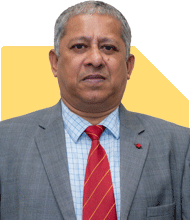Ramalingam Kalirajan |8459 Answers |Ask -Follow
Mutual Funds, Financial Planning Expert - Answered on Apr 15, 2024
He has an MBA in finance from the University of Madras and is a certified financial planner.
He is the director and chief financial planner at Holistic Investment, a Chennai-based firm that offers financial planning and wealth management advice.... more

Sir, Below are my investments : a. Gold investment (not jewellery) of 20k per month (current savings is 1.2 lakhs) b. FD of 20 lakhs c. PF savings of 35 lakhs & PPF savings of 15 lakhs d. No rent, I stay in my own house c. SIP of 85k per month (current savings of 3 lakhs) Nippon India Large Cap Fund - 20k Kotak Multicap Fund - 30k HDFC Flexicap Fund - 15k Invesco Smallcap Fund - 10k Bandhan Smallcap Fund - 10k d. Stocks worth 36 lakhs I have 2 kids studying in 10th & 7th standard respectively. Need to fund their education. Just wanted to check if my investment is good enough to take care of my kids higher education (Engineering or Commerce) & have a retirement corpus of approx 3 cr.
Gold: Consider reducing monthly gold investment if education funding is a priority.
Debt: High FD allocation might be conservative for long-term goals like education & retirement.
Equity: SIPs are good, but review fund overlap (multi-cap & flexi-cap) and small-cap weightage (higher risk).
Stocks: Diversification is key, but individual stock selection requires expertise.
Consult a CFP for personalized advice on optimizing your asset allocation based on risk tolerance and specific goals (education timelines, retirement corpus). They can help you strike a balance between stability and growth potential.
SIPs:
Starting SIPs is a positive step towards your goals. Regularly investing for your children's education and retirement is crucial.
Emergency Fund:
Maintaining an emergency fund like your 20 lakh FD is a wise decision. It provides financial security in case of job loss or unexpected events.
Fixed Income Options:
FDs: While FDs offer guaranteed returns and safety, their interest rates may not always outpace inflation.
Fixed Income Mutual Funds: These can be an alternative. They invest in bonds and debt instruments, offering potentially higher returns than FDs but with slightly more risk. However, they are still considered less volatile than equity funds.
Here are some factors to consider when choosing Fixed Income MFs:
Investment Horizon: Match the fund's maturity with your goals. Short-term debt funds might be suitable for education needs within 5-7 years.
Credit Quality: Invest in funds with good credit quality (low risk of default) to balance returns and stability.
Specific Fund Recommendations are difficult:
It's best to consult a Certified Financial Planner (CFP) for personalized recommendations. They consider your risk tolerance and specific goals when suggesting funds.
House Construction Loan & Future Rent:
The upcoming rental income can help offset your housing loan EMIs, easing your financial burden.
Portfolio Review & Optimization:
Gold Investment: Revisit your monthly gold investment (20k). Consider reducing it if prioritizing education funding, as gold's returns might not keep pace with education costs.
Debt Allocation: The 20 lakh FD and potentially high allocation to debt funds in your SIPs might be too conservative for long-term goals like education (10-15 years) and retirement (20+ years).
Equity SIP Overlap: Review your SIPs (Nippon India Large Cap, Kotak Multicap, HDFC Flexi Cap) for overlap. Consider merging similar fund categories to simplify your portfolio.
Small-Cap Weightage: Small-cap funds (Invesco & Bandhan) carry higher risk. Assess your risk tolerance and adjust allocation if needed.
Stock Selection: Diversification is key in stock selection. Holding individual stocks requires in-depth research and monitoring. Consider a professionally managed equity mutual fund for broader exposure.
Consulting a CFP:
A CFP can create a personalized plan considering your:
Risk tolerance
Specific goals (education timelines, retirement corpus)
Investment horizon for each goal
They can help you optimize your asset allocation across equity, debt, and gold to achieve your financial goals.
You may like to see similar questions and answers below
Ramalingam Kalirajan |8459 Answers |Ask -Follow
Mutual Funds, Financial Planning Expert - Answered on May 27, 2024
Ramalingam Kalirajan |8459 Answers |Ask -Follow
Mutual Funds, Financial Planning Expert - Answered on Jul 17, 2024
Ramalingam Kalirajan |8459 Answers |Ask -Follow
Mutual Funds, Financial Planning Expert - Answered on Jun 27, 2024
Ramalingam Kalirajan |8459 Answers |Ask -Follow
Mutual Funds, Financial Planning Expert - Answered on Jul 15, 2024
Dr Nagarajan J S K |405 Answers |Ask -Follow
NEET, Medical, Pharmacy Careers - Answered on May 16, 2025
Prof Suvasish Mukhopadhyay |651 Answers |Ask -Follow
Career Counsellor - Answered on May 16, 2025
Prof Suvasish Mukhopadhyay |651 Answers |Ask -Follow
Career Counsellor - Answered on May 16, 2025
Radheshyam Zanwar |1634 Answers |Ask -Follow
MHT-CET, IIT-JEE, NEET-UG Expert - Answered on May 16, 2025
Radheshyam Zanwar |1634 Answers |Ask -Follow
MHT-CET, IIT-JEE, NEET-UG Expert - Answered on May 16, 2025
Ashwini Dasgupta |107 Answers |Ask -Follow
Personality Development Expert, Career Coach - Answered on May 16, 2025
Ramalingam Kalirajan |8459 Answers |Ask -Follow
Mutual Funds, Financial Planning Expert - Answered on May 16, 2025
Ramalingam Kalirajan |8459 Answers |Ask -Follow
Mutual Funds, Financial Planning Expert - Answered on May 16, 2025
Milind Vadjikar |1236 Answers |Ask -Follow
Insurance, Stocks, MF, PF Expert - Answered on May 16, 2025
Milind Vadjikar |1236 Answers |Ask -Follow
Insurance, Stocks, MF, PF Expert - Answered on May 16, 2025



























